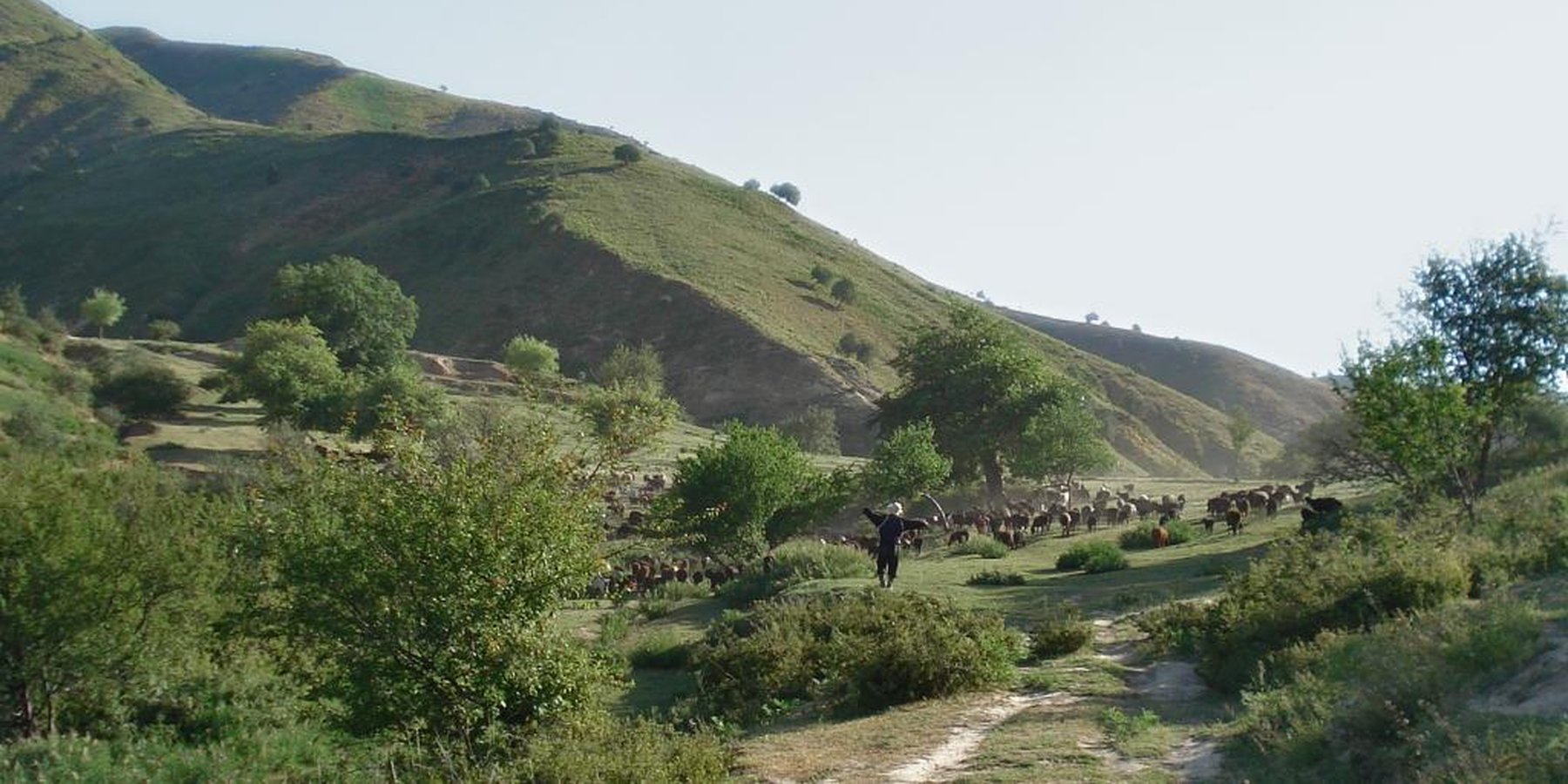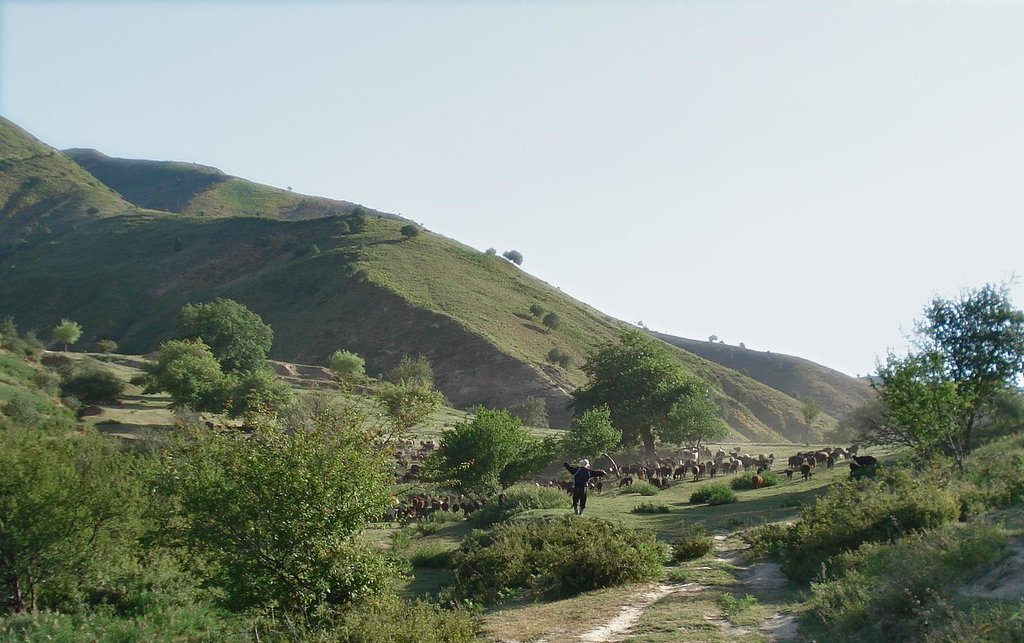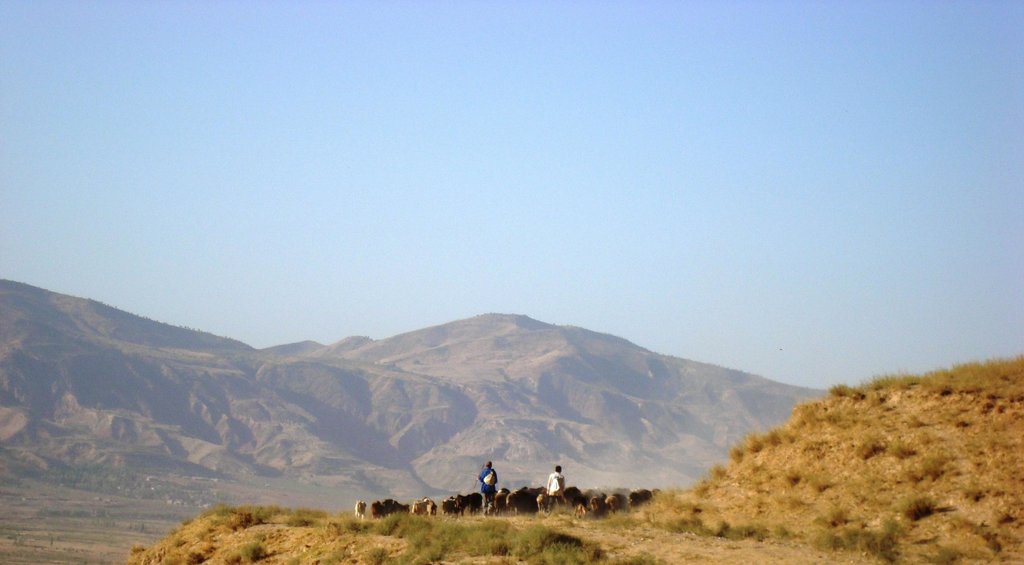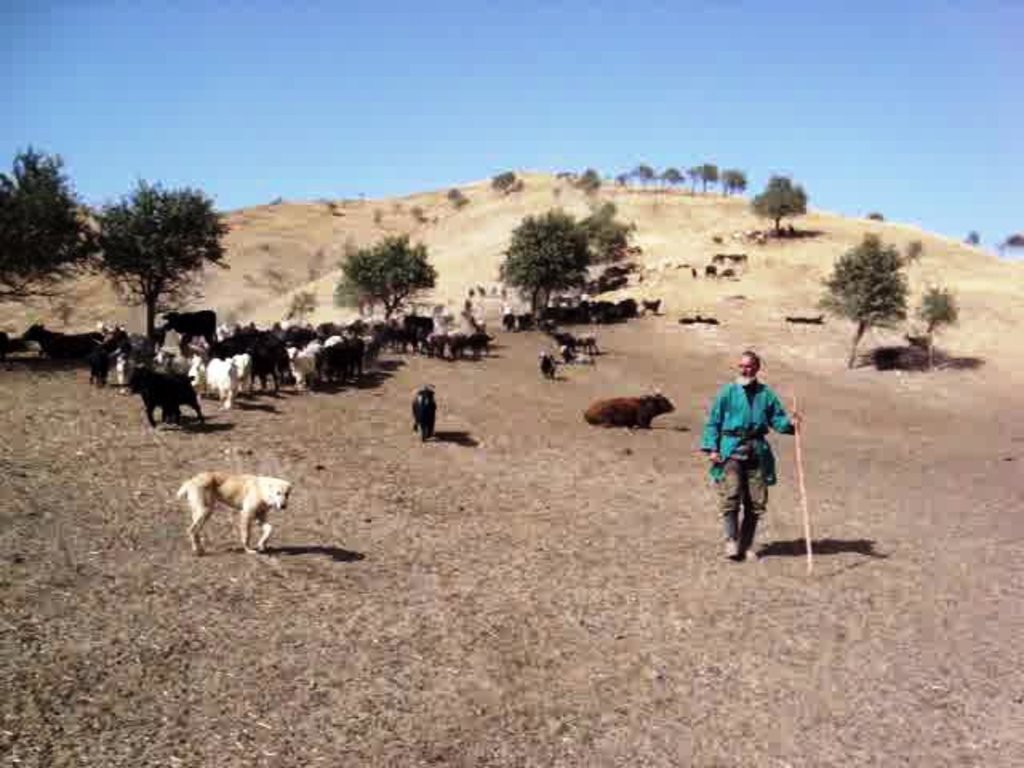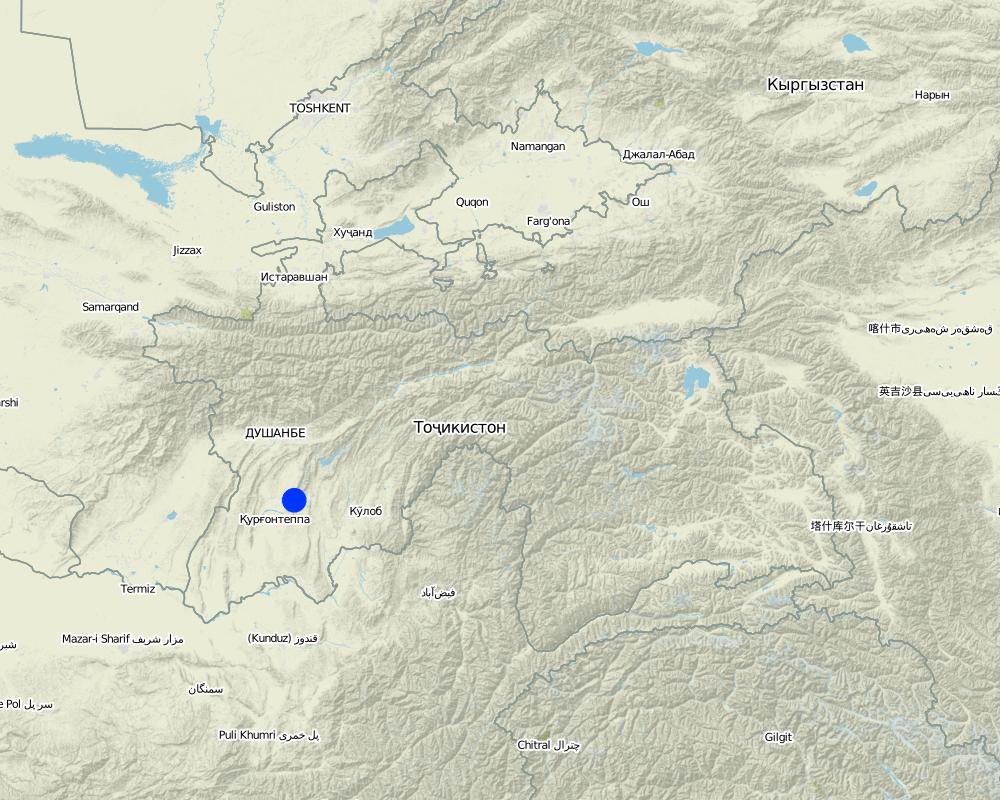Seminomadic individual herding [塔吉克斯坦]
- 创建:
- 更新:
- 编制者: Christian Wirz
- 编辑者: –
- 审查者: David Streiff
Chupon / Dajmardei Khaspi (professional herding)
approaches_2565 - 塔吉克斯坦
查看章节
全部展开 全部收起1. 一般信息
1.2 参与方法评估和文件编制的资源人员和机构的联系方式
有助于对方法进行记录/评估的机构名称(如相关)
CDE Centre for Development and Environment (CDE Centre for Development and Environment) - 瑞士1.3 关于使用通过WOCAT记录的数据的条件
(现场)数据是什么时候汇编的?:
15/08/2008
编制者和关键资源人员接受有关使用通过WOCAT记录数据的条件。:
是
1.4 SLM技术问卷的参考
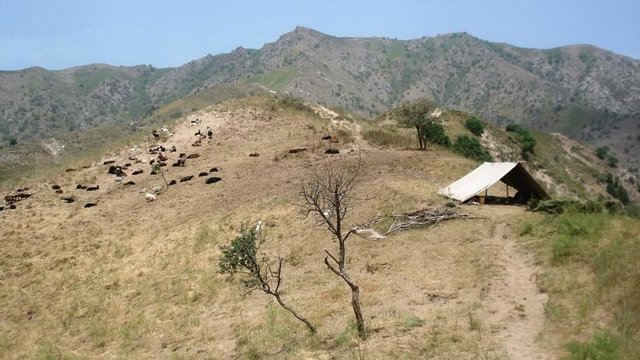
Daily and seasonal rotation on grassland [塔吉克斯坦]
Extensive grazing of sheep and goats by the means of a precise rotational scheme
- 编制者: Christian Wirz
2. SLM方法的描述
2.1 该方法的简要说明
Pasture management by a single herder, assisted either by an employee or by his own grandchildren, in collaboration with the habitants of the nearby village Karsang.
2.2 该方法的详细说明
该方法的详细说明:
Aims / objectives: The herder chooses his territory by the criteria of biomass, vegetation cover and availability of surface water. In his work he gives special attention to fattening the animals, to not losing any of them and to giving back the right animals to the right tenant at the end of the season. For him it is important to be sincere with the tenants and to pay for lost animals.
Methods: Every method applied serves the target of having an obeying herd. The herder works with lots of patience. In the first two weeks he pays very much attention to keeping the herd together, so the animals get used to each other. The rotational grazing scheme also fulfills the requirement of fattening the animals. Grazing the animals by night-time is a method to make the animals obey better. Part of the work is the daily control of the herd to identify sick animals and treat them.The animals are by the way not led by the herder, but rather accompanied by him.
Stages of implementation: After apprenticeship the herder is entrusted with animals from the village and with the generated income can then gradually build up his own herd.
Role of stakeholders: The herder is responsible for the relation with his animals, with the villagers and with the forest department (contract).
2.3 该方法的照片
2.5 采用该方法的国家/地区/地点
国家:
塔吉克斯坦
区域/州/省:
Region of Republican Subordination
有关地点的进一步说明:
Faizabad
Map
×2.6 该方法的开始和终止日期
注明开始年份:
1987
2.7 方法的类型
- 传统/本土
2.8 该方法的主要目的/目标
The Approach focused mainly on other activities than SLM (The focus of this approach is providing the own family with income and meat, by herding own and animals of other herders. It is very important for the herder to keep the animals healthy and to give them all back (the fattest possible) to their tenants.)
The herder's motivation to continue his father's work was that it enabled him to nourish his family. In his work he pays attention to fatten the animals enough to make them survive winter and to give them all back.
The SLM Approach addressed the following problems: The inhabitants of the village give the herder their animals because they know that the animals will be more healthy on the more natural pastures frequented by him compared with village pastures and because the animals get more reserves for winter-time. The herder claims that the animals need 50% less hay and fodder in winter than the animals grazed near the villages.
2.9 推动或妨碍实施本办法所适用的技术的条件
社会/文化/宗教规范和价值观
- 阻碍
Being unable to go to parties and weddings.
Treatment through the SLM Approach: As it is not a problem for the herder (but perhaps for his wife and family?) the problem is not tackled.
财务资源和服务的可用性/可得性
- 阻碍
Paying for lost animals.
Treatment through the SLM Approach: As long as the herder can find the lost animal, even if it is dead, he will not have to pay for it.
机构设置
- 阻碍
It is necessary to have good relations to obtain land from the forest administration.
Treatment through the SLM Approach: As M. worked for the forest department for many years, it was not a problem for him to lease land.
法律框架(土地使用权、土地和水使用权)
- 启动
If tenure were more secure and land use free, M. would divide the rented land into pasture zone, orchard and cropland. This would ensure more self-sufficiency, but probably less income, because he could keep less animals on the reduced pasture area
- 阻碍
其他
- 阻碍
For M. the principal problem are bears (and wolves) killing animals.
Treatment through the SLM Approach: Since he is not allowed to have a rifle to kill wild animals he has to chase them away with his dogs. This means that in summer, when the bears descend to lower areas for fruit in the orchards, he often has to keep awake by night.
3. 相关利益相关者的参与和角色
3.1 该方法涉及的利益相关者及其职责
- 当地土地使用者/当地社区
The herder himself is the protagonist. In some years he employed and educated young herders.
如果涉及多个利益相关者,请注明领导机构:
The herder himself implements the approach
3.2 当地土地使用者/当地社区参与该方法的不同阶段
| 当地土地使用者/当地社区的参与 | 指定参与人员并描述活动 | |
|---|---|---|
| 启动/动机 | 自我动员 | Deciding to be a herder |
| 计划 | 无 | |
| 实施 | 自我动员 | Once M. knew how to treat the animals he could begin work with an own herd. |
| 监测/评估 | 无 | |
| Research | 无 |
3.4 有关SLM技术选择的决策
具体说明谁有权决定选择要实施的技术:
- 仅限土地使用者(自主)
解释:
The herder learnt his profession during an apprenticeship of one year
Decisions on the method of implementing the SLM Technology were made by by land users* alone (self-initiative / bottom-up). M. learned all the technologies from his father, but says, that he only does his job half as well as his father.
4. 技术支持、能力建设和知识管理
4.1 能力建设/培训
是否为土地使用者/其他利益相关者提供培训?:
是
明确受训人员:
- 现场工作人员/顾问
如果相关,请说明性别、年龄、地位、种族等。:
Young men and boys.
培训形式:
- 在职
涵盖的主题:
Teaching of herding method: He tells his assistants not to beat the animals, not to shout at them, to treat animals fairly so they obey and to nourish them sufficiently so they don't walk away by night.
4.2 咨询服务
土地使用者有权使用咨询服务吗?:
否
4.4 监测和评估
注释:
There were no changes in the Approach as a result of monitoring and evaluation: None
There were no changes in the Technology as a result of monitoring and evaluation: None
5. 融资和外部物质支持
5.1 该方法中SLM组成部分的年度预算
如果不知道准确的年度预算,请给出一个范围:
- < 2,000
注释(例如主要的资助来源/主要捐助者):
Approach costs were met by the following donors: local community / land user(s) (All costs): 100.0%
5.2 为土地使用者提供财政/物质支援
土地使用者是否获得实施该技术的财政/物质支持?:
否
5.3 对特定投入的补贴(包括劳动力)
如果土地使用者的劳动力是一项重要的投入,那么是不是:
- 以粮换工
注释:
Also paid in cash: Whereas his grandsons help him and get food therefore, the herder sometimes employs assistants who are paid.
5.4 信用
是否根据SLM活动的方法给予信用值?:
否
6. 影响分析和结论性陈述
6.1 方法的影响
该方法是否帮助土地使用者实施和维护SLM技术?:
- 否
- 是,很少
- 是,中等
- 是,支持力度很大
More biodiversity, less fertility decline, less cover reduction (compared to the grazing method used near the villages)
该方法是否有助于社会和经济弱势群体?:
- 否
- 是,很少
- 是,中等
- 是,支持力度很大
Did other land users / projects adopt the Approach?
- 否
- 是,很少
- 是,中等
- 是,支持力度很大
Young men herding in Faizabad area, one of them only a few ridges in the east of M.
Did the Approach lead to improved livelihoods / human well-being?
- 否
- 是,很少
- 是,中等
- 是,支持力度很大
Whereas in the villages every family has to send someone as a herder once per month, M. earns money for his job and breeds his own animals. On the other hand the family structure is disrupted by the c
Did the Approach help to alleviate poverty?
- 否
- 是,很少
- 是,中等
- 是,支持力度很大
In finacial terms, it did (by generating income), But in terms of education, it did not help.
6.2 土地使用者实施SLM的主要动机
- 增加生产
Animals get fatter than on the common pastures
- 环境意识
The herder somehow has a consciousness of only taking from nature for what he has paid
6.3 方法活动的可持续性
土地使用者能否维持通过该方法实施的措施(无外部支持的情况下)?:
- 是
若是,请说明如何维持:
The herder intends to continue his work as long as physically possible. He though wants to take less animals in the following year and instead more cows and less sheep and goats. He says that cows are easier to keep and in addition, he is paid four times more for a cow than for a sheep or a goat.
6.4 该方法的长处/优点
| 土地使用者眼中的长处/优势/机会 |
|---|
| Each tenant has animals with their own comportment. M. only has to deal with a little number of tenants (and thus animal comportments), whereas the village herds are composed by animals of much more tenants. |
| animals can get used to each other. The composition of the big village herd is not always the same. |
| The herder is always the same and treats the animals fairly: he leads the animals slowly and doesn't shout at them or beat them. |
| 编制者或其他关键资源人员认为的长处/优势/机会 |
|---|
| With around 600-700$ per season, the work as a professional herder is quite well-paid (for rural areas). (How to sustain/ enhance this strength: As soon as work in the foreigner (especially Russia) becomes scarce, herding will be more attractive again.) |
| For people with a tight relationship to nature and god (in the case of M.) this area is a good place, since remote. (How to sustain/ enhance this strength: There will probably continue to be religious, nature-bound young people.) |
6.5 该方法的弱点/缺点以及克服它们的方法
| 土地使用者认为的弱点/缺点/风险 | 如何克服它们? |
|---|---|
| The trees damaged by the animals are a problem from the herder's point of view. | He sees the main problem in the past civil war, when lots of trees were chopped illegally. He says that tree-planting would not be a solution, because then grazing would not be possible anymore either. |
| 编制者或其他关键资源人员认为的弱点/缺点/风险 | 如何克服它们? |
|---|---|
| The way of living is not modern in the young peoples' eyes: They prefer social and urban to rural, solitary life. | As long as poverty predominates in the villages and cities cannot offer enough jobs to young people, agriculture and herding will stay interesting. Though, new (old) forms of herding might appear, such as herding in groups. |
| Night grazing makes sheep eat impalatable (poisonous) plants and than become sick (according to a specialist from CARITAS). | Training and workshops could be a platform for the discussion of such critical aspects. |
链接和模块
全部展开 全部收起链接

Daily and seasonal rotation on grassland [塔吉克斯坦]
Extensive grazing of sheep and goats by the means of a precise rotational scheme
- 编制者: Christian Wirz
模块
无模块


